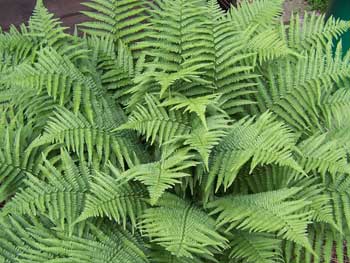Contents:
Common Names | Parts Usually Used | Plant(s) & Culture | Where Found | Medicinal Properties | Biochemical Information
Legends, Myths and Stories | Uses | Formulas or Dosages | Warning | Bibliography
Scientific Names

- Dryopteris filix-mas L.
- Aspidum filix-mas
- Polypodiaceae
- Fern family
Common Names
- Aspidium
- Bear’s paw root
- Knotty brake
- Sweet brake
Parts Usually Used
Rootstock
Back to Top
Description of Plant(s) and Culture

Male fern is a perennial semi-evergreen plant; the dark brown scaly rootstock produces a tuft of fronds which are curled spirally when new but open and mature to a height of 9-24 inches. The fronds are broadly oblong-lanceolate to oblong and pinnate, the lanceolate-acuminate to oblong-lanceolate pinnae themselves pinnatifid or lobed more than halfway to the midrib. Spore clusters appear as two rows of yellow dots on the bottom of each lobe from July to September.
Back to Top
Where Found
Found in woods, ravines, and on rocky slopes all over the world. In the United States, most prevalent Maine, Vermont, New York to Michigan.
Back to Top
Medicinal Properties
Anthelmintic, vermifuge, alterative, astringent
Back to Top
Biochemical Information
Aspidinol, albasidine, phloraspine and filicinic acid.
Back to Top
Legends, Myths and Stories
In the Middle Ages people made a good luck charm out of the rootstock of male fern. They cut off all but five of the curved finger-like fronds from the rootstock, so that it resembled a hand. Called Lucky Hand, Dead Man’s Hand, or St. John’s Hand, this charm was considered to be very strong against bad luck, devils, and witches. It was usually fashioned on June 23rd, St. John’s Eve, so that it would gain extra potency by being fumigated in the fires set that night. Genghis Khan is supposed to have carried one of these charms.
Back to Top
Uses
Male fern is an ancient tapeworm remedy, dating back to the Greeks and Romans, but it must be used with great care. Leaving a male fern medication in the body too long can cause poisoning, so that one to two hours after taking it a purgative (like castor oil) must be used to remove both the worms and the remaining active ingredients. No alcohol or oil may be taken while male fern is being used, as they would increase the absorption of the toxic principle.
Source of oleoresin used to expel tapeworms. It stuns and paralyzes (without killing) tapeworms, round worms, and hook worms.
Good for sores, boils, old wounds, swollen glands, diseases of the spleen, rickets, and epidemic flu.
For external use, a decoction of the rootstock can be added to a footbath for varicose veins. In European folk medicine, a popular belief is that sewing the fronds into a linen bag and applying to affected parts will help rheumatism. At least, it does no harm.
Back to Top
Formulas or Dosages
Since proper preparation and dosage are essential, use male fern for tapeworm only under medical supervision.
Collect the rootstock in the fall.
Decoction: boil 1 lb. rootstock in water and add the liquid to a footbath.
Back to Top
Warning
Toxic poison and skin irritant.
No alcohol or oil should be taken during treatments; they increase the absorption of the toxic principle.
Improper dosages taken internally can lead to blindness and death.
Not for use during pregnancy.
Back to Top
Bibliography
![]() The Herb Book
The Herb Book, by John Lust, Bantam Books, 666 Fifth Avenue, New York, NY. copyright 1974.
![]() Planetary Herbology
Planetary Herbology, by Michael Tierra, C.A., N.D., O.M.D., Lotus Press, PO Box 325, Twin Lakes. WI 53181., Copyright 1988, published 1992
![]() Indian Herbalogy of North America
Indian Herbalogy of North America, by Alma R. Hutchens, Shambala Publications, Inc., Horticultural Hall, 300 Massachusetts Avenue, Boston, Massachusetts 02115, 1973
![]() Culpeper’s Complete Herbal & English Physician: Updated With 117 Modern Herbs
Culpeper’s Complete Herbal & English Physician: Updated With 117 Modern Herbs, by Nicholas Culpeper, Meyerbooks, publisher, PO Box 427, Glenwood, Illinois 60425, 1990, (reprint of 1814)
![]() Eastern/Central Medicinal Plants
Eastern/Central Medicinal Plants, by Steven Foster and James A. Duke., Houghton Mifflin Company, 215 Park Avenue South, New York, NY 10000
![]() The Yoga of Herbs: An Ayurvedic Guide to Herbal Medicine
The Yoga of Herbs: An Ayurvedic Guide to Herbal Medicine, by Dr. David Frawley & Dr. Vasant Lad, Lotus Press, Twin Lakes, Wisconsin, Second edition, 1988.
![]() Webster’s New World Dictionary
Webster’s New World Dictionary, Third College Edition, Victoria Neufeldt, Editor in Chief, New World Dictionaries: A Division of Simon & Schuster, Inc., 15 Columbus Circle, New York, NY 10023
